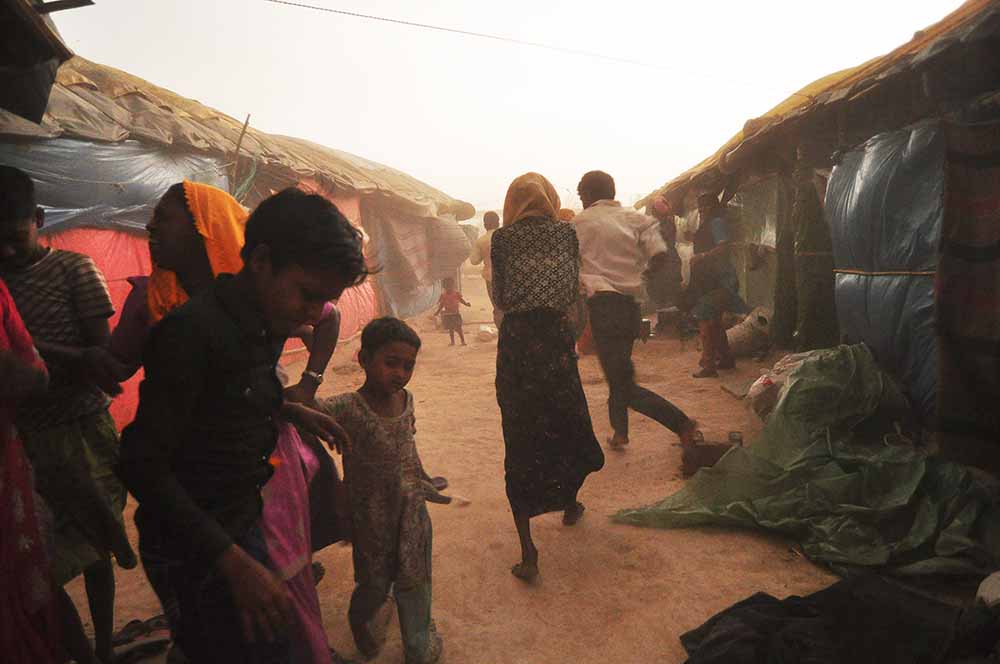

“In a larger perspective, it would only be natural if diplomatic efforts to stabilize our Northeastern borders with Myanmar and Bangladesh were undertaken with cooperation with powers which share our interests. Most importantly, India, Myanmar and Bangladesh share a common interest in combating radical Islamic groups, whose primary aim is to destabilize all three neighbors”, says the author.
As Myanmar, Bangladesh and India face the Rohingya challenge. ‘Rohingya’ has become a household word in India, more so after Minister of State for Home Affairs Kiren Rijiju proclaimed on September 5 that the Rohingya were “illegal” immigrants in India “who stand to be deported”. The outrage that accompanied the plight of the Rohingya was not only in sections of people in India, but also across the Western and Islamic world.
India has stood its ground, maintaining that recent events were triggered by cross-border attacks across the Bangladesh-Myanmar border by radical Islamic groups. But a number of questions remain on how we are going to deal with an estimated 45,000 Rohingya refugees from Myanmar who have entered India since 2012. Moreover, the massacre of Hindu Rohingya by Islamic Rohingya terrorists has further outraged and polarized Indian public opinion.
The Rohingya maintain they are an indigenous community of western Myanmar, bordering Bangladesh. They largely immigrated from what is now Bangladesh, during British rule. They are predominantly Muslim, with an estimated population of 1.2-1.3 million in the north of Myanmar’s Rakhine province, bordering Bangladesh. The southern part of Rakhine, bordering Mizoram, is predominantly Buddhist, with a Hindu minority. Ever since independence, and more so after U Ne Win dictatorship, the Rohingya are not considered as Myanmar citizens. They have been subject to discrimination on issues of health, education and employment. The animosity of the army, which dominates national life in Myanmar, toward the Rohingya has increased ever since sections of Rohingya formed armed groups to wage an ill-advised armed struggle after indoctrination in Pakistan. The Myanmar army has continuously battled 22 ethnic insurgencies in the country on its borders with China and Thailand. But seldom, if ever, has the army undertaken the sort of scorched earth policy it has adopted against the Rohingya. And never has the Buddhist clergy reacted so strongly, as in what has transpired in Rakhine, after recent coordinated cross-border attacks on police posts and the army by the Rohingya Solidarity Army. Myanmar has legitimate concerns about the radicalization of its Muslim population in Rakhine.
The army action has resulted in over 4 lakh Rohingya — men, women and children — fleeing to Bangladesh. India now houses an estimated 45,000 Rohingya refugees. While India initially focused largely on Rohingya terrorist attacks in Myanmar, it has now realized the extent of burdens, damage and difficulties imposed on the friendly government of Sheikh Hasina by the huge inflow of refugees. While New Delhi has commenced airlifting relief supplies to Bangladesh, India should join Bangladesh and Myanmar bilaterally, and even through tripartite meetings, to seek a coordinated effort to obtain international financial and diplomatic support, which would facilitate an early and time-bound process of repatriation of the refugees, with their safety and security guaranteed, on their return to their homes.
India-Myanmar relations have been looking upwards in recent years, even though much improvement is needed in the implementation of Indian-aided projects there, if we are to make any impression of our relevance, in the face of some aggressive Chinese involvement. Myanmar has a crucial role in supplementing our efforts to deal with insurgencies backed by Pakistan and China in our landlocked Northeastern states, notably Manipur and Nagaland. India is currently building the Kaladan corridor, linking Northeastern states across the Rakhine state with the Bay of Bengal, through the deep-water Sittwe Port in Myanmar. New Delhi has just completed the construction of the port. India has also pledged resources for the development of Rakhine, in an effort that will be helpful in addressing Rohingya grievances. These are crucial projects strategically as they are located alongside a massive Chinese transportation/energy corridor, linking China’s Yunnan province with Myanmar’s Bay of Bengal Port of Kyaukpyu.
As global television networks and UN relief organizations focused on the miseries of the Rohingya in Bangladesh, the issue became center-stage. The UN Secretary-General bluntly labelled Myanmar government actions as “ethnic cleansing”. India has made it clear that Islamic terror groups triggered the violence. China, while expressing support for Myanmar’s moves, was more nuanced in the UN Security Council. While backing Myanmar’s moves to protect its security in Rakhine, China also backed a Security Council resolution expressing concern at reports of Myanmar resorting to excessive violence and calling on Myanmar to take corrective action. Russia, while welcoming some steps taken by Myanmar, also took note of reports of violence. Not surprisingly, it was Myanmar’s former colonial rulers, the British, who took the lead in condemning Suu Kyi. Whitehall was quite obviously taken aback by Suu Kyi placing her country’s interests first, and not behaving, as it expected, like a pet poodle. American policy as enunciated by Secretary of State Tillerson was mercifully more balanced and rational.
In these circumstances, New Delhi should develop a more comprehensive approach, which would enable the safe return of Rohingya, from both Bangladesh and India. External Affairs Minister Sushma Swaraj assured Bangladesh PM Sheikh Hasina of India’s support, even as Myanmar military actions have led to a continuing influx of refugees. At the same time, it is essential that India, Myanmar and Bangladesh join hands to see that radical Islamic groups are prevented from infiltrating through Bangladesh to Rakhine. It would also be useful if India joined hands with donors like Japan, Germany and the US to ensure coordinated flow of economic assistance to ensure that the Rohingya receive better education, health and other facilities on their return. In a larger perspective, it would only be natural if diplomatic efforts to stabilize our Northeastern borders with Myanmar and Bangladesh were undertaken with cooperation with powers which share our interests. Most importantly, India, Myanmar and Bangladesh share a common interest in combating radical Islamic groups, whose primary aim is to destabilize all three neighbors.
One of the success stories of Indian diplomacy has been that regionally we have been able to isolate an obdurate and obstructive Pakistan by imaginative regional initiatives across our eastern land and maritime frontiers through organizations like BIMSTEC. Addressing the Rohingya crisis imaginatively and successfully will give a boost to our “Act East” policy. Even as SAARC languishes, BIMSTEC should remain the focus of India’s efforts for regional economic integration.
(The author is a career diplomat)





Be the first to comment